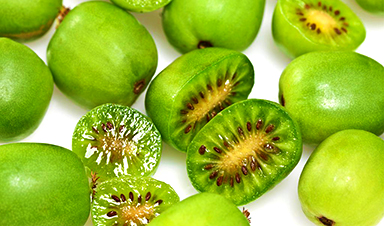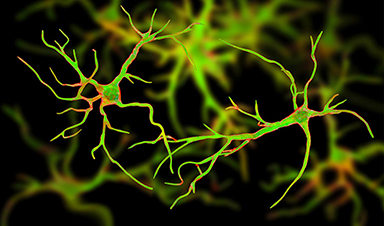Using a mouse model, Japanese researchers unleash the likely mechanism of action of Actinidia arguta (sarunashi) juice on lung cancer development.
Lung cancer is a leading cause of death in Japan and across the globe. Among all the cancers, lung cancer has one of the lowest five-year survival rates. Smoking tobacco and using tobacco-based products are known to heavily contribute to the development of lung cancer. It is a clinically established fact that the active ingredients in various fruits minimize the risk of chronic diseases including cancer. "Sarunashi" (Actinidia arguta) is an edible fruit cultivated in Japan's Okayama Prefecture.
Using a mouse model, researchers from Okayama University led by Dr. Sakae Arimoto-Kobayashi, Associate Professor in the Faculty of Pharmaceutical Sciences, Okayama University, have shown that Sarunashi juice and its constituting component isoquercetin (isoQ) help prevent and reduce lung cancer.

Actinidia arguta, also known as the hardy kiwi, is a perennial vine that originates from Japan, Korea, Northern China, and the Russian Far East. It produces a small, smooth-skinned kiwifruit, unlike most other species within the genus, which have a hair-like fiber on the exterior.
To this end, the team induced tumor growth in mice using NNK, a known cancer-causing compound present in tobacco products. Using a series of experiments and controls, the team studied the effects of sar-j and isoQ on lung tumorigenesis in mice.
The results were encouraging: The number of tumor nodules per mouse lung in the group that received NNK injections and oral doses of A. arguta juice was significantly lower than that in the group injected with NNK only. Moreover, the oral administration of isoQ also reduced the number of nodules in the mouse lungs.
Finally, using cell-based experiments, the team also showed that sar-j suppressed the action of "Akt," a key protein involved in cancer signaling. It is a known fact that Akt and an associated protein called "PI3k," get over-activated in several human cancers.
Co-author Katsuyuki Kiura, a Professor in the Department of Allergy and Respiratory Medicine, Okayama University Hospital, muses, "Sar-j and isoQ reduced NNK-induced lung tumorigenesis. Sar-j targets both the initiation and growth or progression steps during carcinogenesis, specifically via anti-mutagenesis, stimulation of alkyl DNA adduct repair, and suppression of Akt-mediated growth signaling. IsoQ might contribute in part to the biological effects of sar-j via suppression of Akt phosphorylation, but it may not be the main active ingredient."
Their findings were published on December 9, 2022, in Genes and Environment.
In summary, the study shows that lung tumorigenesis in mice was suppressed following the oral intake of sar-j. Although clinical trials are warranted, the constituting components of sar-j, including isoQ, seem to be attractive candidates for chemoprevention.
News
Researchers highlight five pathways through which microplastics can harm the brain
Microplastics could be fueling neurodegenerative diseases like Alzheimer's and Parkinson's, with a new study highlighting five ways microplastics can trigger inflammation and damage in the brain. More than 57 million people live with dementia, [...]
Tiny Metal Nanodots Obliterate Cancer Cells While Largely Sparing Healthy Tissue
Scientists have developed tiny metal-oxide particles that push cancer cells past their stress limits while sparing healthy tissue. An international team led by RMIT University has developed tiny particles called nanodots, crafted from a metallic compound, [...]
Gold Nanoclusters Could Supercharge Quantum Computers
Researchers found that gold “super atoms” can behave like the atoms in top-tier quantum systems—only far easier to scale. These tiny clusters can be customized at the molecular level, offering a powerful, tunable foundation [...]
A single shot of HPV vaccine may be enough to fight cervical cancer, study finds
WASHINGTON -- A single HPV vaccination appears just as effective as two doses at preventing the viral infection that causes cervical cancer, researchers reported Wednesday. HPV, or human papillomavirus, is very common and spread [...]
New technique overcomes technological barrier in 3D brain imaging
Scientists at the Swiss Light Source SLS have succeeded in mapping a piece of brain tissue in 3D at unprecedented resolution using X-rays, non-destructively. The breakthrough overcomes a long-standing technological barrier that had limited [...]
Scientists Uncover Hidden Blood Pattern in Long COVID
Researchers found persistent microclot and NET structures in Long COVID blood that may explain long-lasting symptoms. Researchers examining Long COVID have identified a structural connection between circulating microclots and neutrophil extracellular traps (NETs). The [...]
This Cellular Trick Helps Cancer Spread, but Could Also Stop It
Groups of normal cbiells can sense far into their surroundings, helping explain cancer cell migration. Understanding this ability could lead to new ways to limit tumor spread. The tale of the princess and the [...]
New mRNA therapy targets drug-resistant pneumonia
Bacteria that multiply on surfaces are a major headache in health care when they gain a foothold on, for example, implants or in catheters. Researchers at Chalmers University of Technology in Sweden have found [...]
Current Heart Health Guidelines Are Failing To Catch a Deadly Genetic Killer
New research reveals that standard screening misses most people with a common inherited cholesterol disorder. A Mayo Clinic study reports that current genetic screening guidelines overlook most people who have familial hypercholesterolemia, an inherited disorder that [...]
Scientists Identify the Evolutionary “Purpose” of Consciousness
Summary: Researchers at Ruhr University Bochum explore why consciousness evolved and why different species developed it in distinct ways. By comparing humans with birds, they show that complex awareness may arise through different neural architectures yet [...]
Novel mRNA therapy curbs antibiotic-resistant infections in preclinical lung models
Researchers at the Icahn School of Medicine at Mount Sinai and collaborators have reported early success with a novel mRNA-based therapy designed to combat antibiotic-resistant bacteria. The findings, published in Nature Biotechnology, show that in [...]
New skin-permeable polymer delivers insulin without needles
A breakthrough zwitterionic polymer slips through the skin’s toughest barriers, carrying insulin deep into tissue and normalizing blood sugar, offering patients a painless alternative to daily injections. A recent study published in the journal Nature examines [...]
Multifunctional Nanogels: A Breakthrough in Antibacterial Strategies
Antibiotic resistance is a growing concern - from human health to crop survival. A new study successfully uses nanogels to target and almost entirely inhibit the bacteria P. Aeruginosa. Recently published in Angewandte Chemie, the study [...]
Nanoflowers rejuvenate old and damaged human cells by replacing their mitochondria
Biomedical researchers at Texas A&M University may have discovered a way to stop or even reverse the decline of cellular energy production—a finding that could have revolutionary effects across medicine. Dr. Akhilesh K. Gaharwar [...]
The Stunning New Push to Protect the Invisible 99% of Life
Scientists worldwide have joined forces to build the first-ever roadmap for conserving Earth’s vast invisible majority—microbes. Their new IUCN Specialist Group reframes conservation by elevating microbial life to the same urgency as plants and [...]
Scientists Find a Way to Help the Brain Clear Alzheimer’s Plaques Naturally
Scientists have discovered that the brain may have a built-in way to fight Alzheimer’s. By activating a protein called Sox9, researchers were able to switch on star-shaped brain cells known as astrocytes and turn them into [...]





















